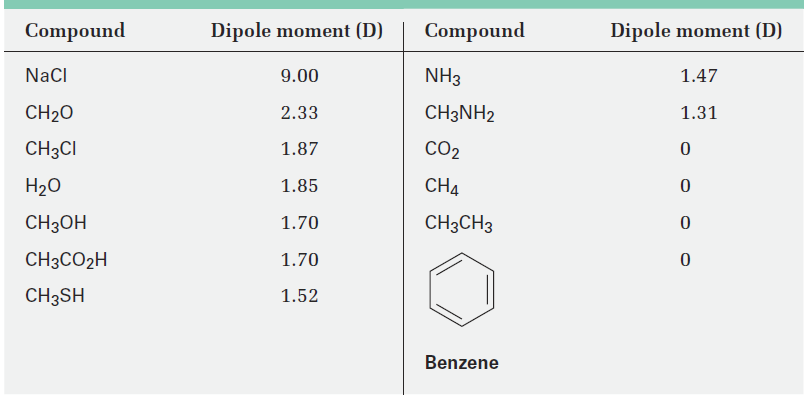


 علم الكيمياء
علم الكيمياء 
 الكيمياء التحليلية
الكيمياء التحليلية 
 الكيمياء الحياتية
الكيمياء الحياتية 
 الكيمياء العضوية
الكيمياء العضوية 
 الكيمياء الفيزيائية
الكيمياء الفيزيائية
 الكيمياء اللاعضوية
الكيمياء اللاعضوية 
 مواضيع اخرى في الكيمياء
مواضيع اخرى في الكيمياء
 الكيمياء الصناعية
الكيمياء الصناعية |
Read More
Date: 27-9-2020
Date: 8-9-2019
Date: 16-9-2019
|
Polar Covalent Bonds: Dipole Moments
Just as individual bonds are often polar, molecules as a whole are often polar as well. Molecular polarity results from the vector summation of all individual bond polarities and lone-pair contributions in the molecule. As a practical matter, strongly polar substances are often soluble in polar solvents like water, whereas less polar substances are insoluble in water.
Net molecular polarity is measured by a quantity called the dipole moment and can be thought of in the following way: assume that there is a center of mass of all positive charges (nuclei) in a molecule and a center of mass of all negative charges (electrons). If these two centers don’t coincide, then the Molecule has a net polarity.
The dipole moment, μ (Greek mu), is defined as the magnitude of the charge Q at either end of the molecular dipole times the distance r between the charges, μ= Q x r. Dipole moments are expressed in debyes (D), where 1 D = 3.336 x 10-30 coulomb meters (C · m) in SI units. For example, the unit charge on an electron is 1.60 x 10-19 C. Thus, if one positive charge and one negative charge are separated by 100 pm (a bit less than the length of a typical covalent bond), the dipole moment is 1.60 x 10-29 C · μ, or 4.80 D.


Dipole moments for some common substances are given in Table above . Of the compounds shown in the table, sodium chloride has the largest dipole moment (9.00 D) because it is ionic. Even small molecules like water (μ = 1.85 D), methanol (CH3OH; μ = 1.70 D), and ammonia (μ = 1.47 D), have substantial dipole moments, however, both because they contain strongly electronegative atoms (oxygen and nitrogen) and because all three molecules have lone-pair electrons. The lone-pair electrons on oxygen and nitrogen stick outinto space away from the positively charged nuclei, giving rise to a considerable charge separation and making a large contribution to the dipole moment.

In contrast with water, methanol, and ammonia, molecules such as carbon dioxide, methane, ethane, and benzene have zero dipole moments. Because of the symmetrical structures of these molecules, the individual bond polarities and lone-pair contributions exactly cancel.




|
|
|
|
دراسة يابانية لتقليل مخاطر أمراض المواليد منخفضي الوزن
|
|
|
|
|
|
|
اكتشاف أكبر مرجان في العالم قبالة سواحل جزر سليمان
|
|
|
|
|
|
|
اتحاد كليات الطب الملكية البريطانية يشيد بالمستوى العلمي لطلبة جامعة العميد وبيئتها التعليمية
|
|
|